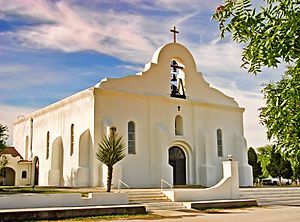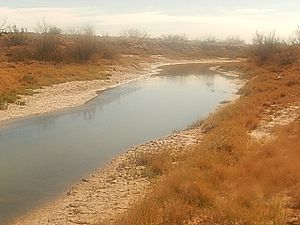Butterfield Overland Mail in Texas facts for kids
Quick facts for kids Butterfield Overland Mail |
|
|---|---|

Pinery Station in Guadalupe Mountains National Park
|
|
| Type | historic trail |
| Location | New Mexico Territory near Anthony - Indian Territory near Sherman |
| Official name: Butterfield Overland Mail Corridor | |
| Type | U.S. historic district |
| Designated | August 27, 2014 |
| Reference no. | 14000524 |
| Location | 400 Pine Canyon Rd. Guadalupe Mountains National Park |
| Area | 2,401.3 acres (971.8 ha) |
| Lua error in Module:Location_map at line 420: attempt to index field 'wikibase' (a nil value). | |
The Butterfield Overland Mail was a very important mail and passenger service in the United States. It operated from 1857 to 1861. This service connected San Francisco, California, all the way to St. Louis, Missouri. It was a huge journey across the country!
In Texas, the Butterfield Overland Mail route was very long. It was so long that it was split into two main parts, each with its own manager. This service helped deliver mail and people across vast distances. It was a vital link for communication and travel before railroads were common.
Contents
What Was the Butterfield Overland Mail?
The Butterfield Overland Mail was a stagecoach service. It was created by the U.S. Congress in 1857. Its main goal was to deliver mail and passengers across the southern United States. This was a time when traveling across the country was very difficult.
The route was incredibly long, stretching over 2,800 miles. It took about 25 days to complete the entire trip. Stagecoaches traveled day and night, stopping at special stations along the way. These stations provided fresh horses, food, and a place for travelers to rest.
The Texas Route: A Long Journey
The Texas part of the Butterfield Overland Mail route was a major section. It started near Franklin, Texas and went all the way to the Red River. From there, it continued into Indian Territory (which is now Oklahoma).
The original route in West Texas went through tough, dry areas. It passed places like Hueco Tanks and Pinery Station. These areas were often short on water. Finding enough water for the horses and passengers was a big challenge.
Changes to the Texas Route
Over time, the route in Texas was changed. This happened in 1859. The main reasons for the changes were:
- To find better water sources.
- To offer more safety from dangers along the way.
- To serve more towns and settled areas.
The new route used parts of the San Antonio–El Paso Road. This road was already more established. It meant the stagecoaches could get water more easily. It also allowed them to pass through more populated areas. This helped the mail service reach more people.
One important change was near Jacksboro, Texas. In 1860, a new toll bridge was built at Bridgeport, Texas. This bridge helped avoid delays when the Trinity River was flooded. These changes made the journey a bit smoother and faster.
Important Stations in Texas
Along the Butterfield Overland Mail route, there were many stations. These were like rest stops for the stagecoaches, horses, and passengers. They were super important for such a long trip.
West Texas Stations (5th Division)
The 5th Division covered the western part of Texas. It started near Franklin.
- Franklin Station: This was a key stop in El Paso, Texas. It was the halfway point of the entire Butterfield route. It was also the main office for the 5th Division.
Old Route (used until August 1859)

- Hueco Tanks Station: Located about 30 miles from Franklin. This area is known for its natural rock basins that collect rainwater.
- Pinery Station: Located near Guadalupe Mountains National Park. This station is now preserved as a historic site. It's a great example of the old stations.
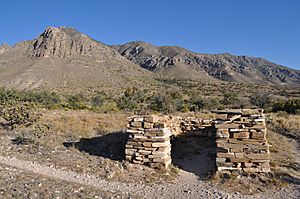
- Pope's Camp Station: This station was on the east bank of the Pecos River. Crossing the Pecos was a big deal.
New Route (used from August 1859)
This route followed the San Antonio–El Paso Road more closely.
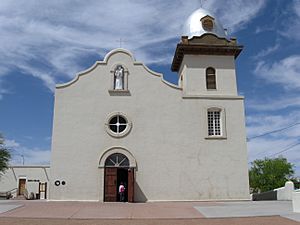
- Ysleta: One of the first stops after Franklin.
- San Elizario: Another early stop on the new route.
- Fort Davis Station: Located near Fort Davis National Historic Site. This area offered more protection.
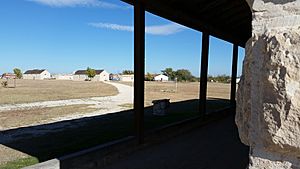
- Fort Stockton Station: An important stop that helped connect the new route to the older one.
- Horse Head Crossing Station: This was a very important point on the Pecos River. A ferry was added here in 1859 to help coaches cross the river.
East Texas Stations (6th Division)
The 6th Division covered the eastern part of Texas. It started from Fort Chadbourne.
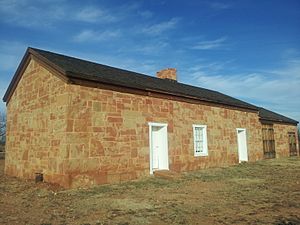
- Fort Chadbourne: A key starting point for this division.
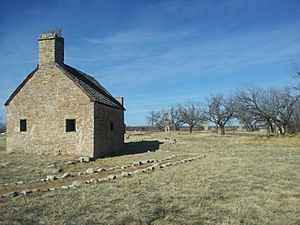
- Phantom Hill Station: Located north of what is now Abilene, Texas.
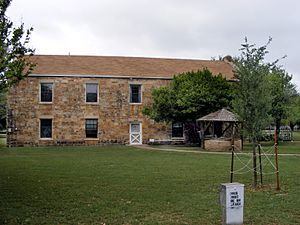
- Fort Belknap Station: Another important fort that served as a station.
- Jacksboro Station: A significant stop before the route changed.
- Sherman Station: This was one of the last stops in Texas before crossing the Red River into Indian Territory.
- Colbert's Ferry: The crossing point over the Red River. This ferry took the stagecoaches into Indian Territory.
Why the Service Ended
The Butterfield Overland Mail service in Texas stopped on March 30, 1861. This was because of the start of the American Civil War. The route was too close to the conflict, and it became unsafe to operate. The service was then moved to a more northern route.
Legacy of the Butterfield Overland Mail
Even though it only ran for a few years, the Butterfield Overland Mail was very important. It showed that a long-distance mail service was possible. It helped connect the East and West. Parts of the old route, like Pinery Station, are now preserved. They are part of places like Guadalupe Mountains National Park. These sites are listed on the National Register of Historic Places. This means they are important historical places that are protected.


